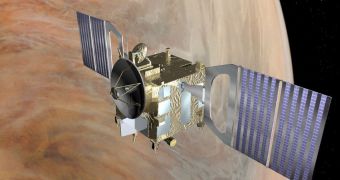Data sent back by the European Space Agency's (ESA) Venus Express orbiter have revealed that our neighboring planet also features an ozone layer, high above its surface. The existence of such a layer has never even been considered before.
Scientists expect that more in-depth studies of the atmosphere surrounding Venus will yield promising directions of research in the field of astrobiology. The information could also be used to refine the parameters of our search for extraterrestrial lifeforms.
After the atmospheric profile of Venus is captured, scientists will be able to compare it with similar datasets covering Earth and Mars. These analyses could be used to tease out the factors that make our world inhabitable, and the other two nothing more than barren wastelands.
The ozone layer was discovered using the SPectroscopy for Investigation of Characteristics of the Atmosphere of Venus (SPICAV) instrument aboard the orbiter. At the time the discovery was made, the tool was focused on analyzing starlight.
Various chemicals have different spectral signatures, meaning that they influence light passing through them in a manner that can be quantified. Starlight coming in from other worlds was therefore used as a backlight, against which Venus Express conducted its investigation.
Astronomers observed an interesting spike in the readings, which seemed to suggest that a portion of ultraviolet light coming in from other stars was being absorbed by the atmosphere. The only chemical that is known to be capable of doing this is ozone.
Early theories indicate that sunlight itself is responsible for producing the ozone. When photons slam into carbon dioxide molecules – of which there are many in the air above Venus – they can release oxygen atoms. Each ozone molecule is made up of three oxygen atoms (O3).
“This detection gives us an important constraint on understanding the chemistry of Venus' atmosphere,” study leader Franck Montmessin says. The French researcher is based at the University of Versailles (UVSQ) Service d'Aeronomie.
“We can use these new observations to test and refine the scenarios for the detection of life on other worlds,” he goes on to say. The discovery of ozone around Venus is interesting because oxygen was only produced in Earth's atmosphere through the action of microbes.
As such, it could be that other worlds exhibiting both ozone and oxygen in their atmosphere may have life on their surfaces as well. O3 also plays an important role in protecting organisms from the mutation-causing effects of excessive exposure to UV light.

 14 DAY TRIAL //
14 DAY TRIAL //